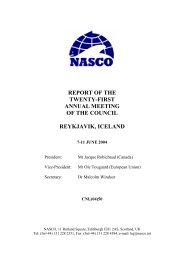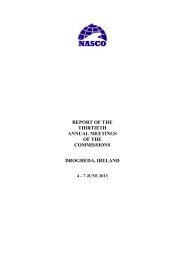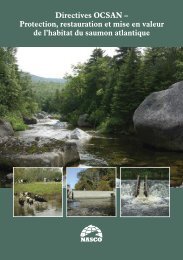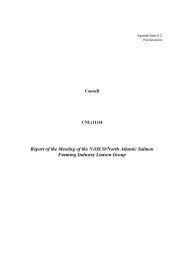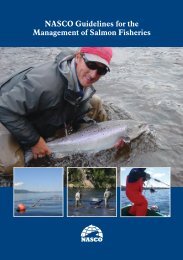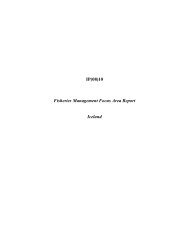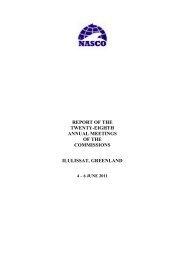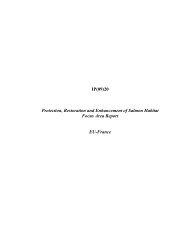Report of the 2005 ICES/NASCO Symposium on Interactions ...
Report of the 2005 ICES/NASCO Symposium on Interactions ...
Report of the 2005 ICES/NASCO Symposium on Interactions ...
Create successful ePaper yourself
Turn your PDF publications into a flip-book with our unique Google optimized e-Paper software.
NINA SPECIAL REPORT 34<br />
Annex 1: Abstracts<br />
Note:These abstracts are those submitted prior to <str<strong>on</strong>g>the</str<strong>on</strong>g><br />
symposium.<br />
Keynote Presentati<strong>on</strong>s<br />
Wild Atlantic salm<strong>on</strong> - so valuable, so<br />
vulnerable<br />
Pat O’Reilly<br />
After briefly surveying <str<strong>on</strong>g>the</str<strong>on</strong>g> envir<strong>on</strong>mental, social and<br />
ec<strong>on</strong>omic benefits <str<strong>on</strong>g>of</str<strong>on</strong>g> healthy wild salm<strong>on</strong> stocks to<br />
communities in countries bordering <str<strong>on</strong>g>the</str<strong>on</strong>g> North Atlantic, in<br />
this keynote address <str<strong>on</strong>g>the</str<strong>on</strong>g> author also highlights <str<strong>on</strong>g>the</str<strong>on</strong>g> Atlantic<br />
salm<strong>on</strong>’s ic<strong>on</strong>ic significance worldwide. There follows a<br />
brief review <str<strong>on</strong>g>of</str<strong>on</strong>g> past and present pressures <strong>on</strong> salm<strong>on</strong><br />
stocks not <strong>on</strong>ly via direct exploitati<strong>on</strong> but also via damage<br />
to <str<strong>on</strong>g>the</str<strong>on</strong>g>ir envir<strong>on</strong>ment and measures already taken or<br />
underway to reduce impacts via <str<strong>on</strong>g>the</str<strong>on</strong>g> air, land and fresh<br />
water. Finally, <str<strong>on</strong>g>the</str<strong>on</strong>g> presenter focuses <strong>on</strong> <str<strong>on</strong>g>the</str<strong>on</strong>g> marine<br />
envir<strong>on</strong>ment and proposes aspects which, with<br />
internati<strong>on</strong>al cooperati<strong>on</strong> and partnership working, need<br />
to be urgently addressed in order to forge a sustainable<br />
future for <str<strong>on</strong>g>the</str<strong>on</strong>g> salm<strong>on</strong> farming industry and to c<strong>on</strong>serve<br />
for future generati<strong>on</strong>s healthy, abundant wild salm<strong>on</strong><br />
stocks.<br />
A global review <str<strong>on</strong>g>of</str<strong>on</strong>g> <str<strong>on</strong>g>the</str<strong>on</strong>g> salm<strong>on</strong> farming<br />
industry and developments with regard to<br />
sustainability<br />
Helge Midttun<br />
Farming <str<strong>on</strong>g>of</str<strong>on</strong>g> Atlantic salm<strong>on</strong> is a young industry. It started<br />
in Norway in <str<strong>on</strong>g>the</str<strong>on</strong>g> 1960s and has since spread to various<br />
corners <str<strong>on</strong>g>of</str<strong>on</strong>g> <str<strong>on</strong>g>the</str<strong>on</strong>g> world. In 2004, producti<strong>on</strong> <str<strong>on</strong>g>of</str<strong>on</strong>g> Atlantic<br />
salm<strong>on</strong> made up close to 80% <str<strong>on</strong>g>of</str<strong>on</strong>g> <str<strong>on</strong>g>the</str<strong>on</strong>g> global producti<strong>on</strong> <str<strong>on</strong>g>of</str<strong>on</strong>g><br />
salm<strong>on</strong>ids, which was around 1.5 milli<strong>on</strong> t<strong>on</strong>nes. The<br />
largest salm<strong>on</strong>-producing countries today are Norway,<br />
Chile, Scotland and Canada. In <str<strong>on</strong>g>the</str<strong>on</strong>g> Nor<str<strong>on</strong>g>the</str<strong>on</strong>g>rn hemisphere,<br />
Norway is <str<strong>on</strong>g>the</str<strong>on</strong>g> biggest producer <str<strong>on</strong>g>of</str<strong>on</strong>g> Atlantic salm<strong>on</strong>, and<br />
<str<strong>on</strong>g>the</str<strong>on</strong>g> salm<strong>on</strong> industry has become an important means <str<strong>on</strong>g>of</str<strong>on</strong>g><br />
income for many communities al<strong>on</strong>g <str<strong>on</strong>g>the</str<strong>on</strong>g> l<strong>on</strong>g coastline.<br />
Norway has clean waters and envir<strong>on</strong>mental c<strong>on</strong>diti<strong>on</strong>s<br />
that are well suited for building a viable and sustainable<br />
aquaculture industry. Like any o<str<strong>on</strong>g>the</str<strong>on</strong>g>r industrialised food<br />
producti<strong>on</strong> system, salm<strong>on</strong> farming impacts <str<strong>on</strong>g>the</str<strong>on</strong>g><br />
envir<strong>on</strong>ment, and <str<strong>on</strong>g>the</str<strong>on</strong>g> salm<strong>on</strong> producers must accept that<br />
<str<strong>on</strong>g>the</str<strong>on</strong>g>y will be subject to rigorous evaluati<strong>on</strong> <str<strong>on</strong>g>of</str<strong>on</strong>g> <str<strong>on</strong>g>the</str<strong>on</strong>g><br />
envir<strong>on</strong>mental impact <str<strong>on</strong>g>of</str<strong>on</strong>g> <str<strong>on</strong>g>the</str<strong>on</strong>g>ir activities. Fortunately,<br />
through focus and dedicati<strong>on</strong> from all stakeholders in <str<strong>on</strong>g>the</str<strong>on</strong>g><br />
26<br />
industry, and in close collaborati<strong>on</strong> with <str<strong>on</strong>g>the</str<strong>on</strong>g> authorities,<br />
many <str<strong>on</strong>g>of</str<strong>on</strong>g> <str<strong>on</strong>g>the</str<strong>on</strong>g> envir<strong>on</strong>mental problems associated with <str<strong>on</strong>g>the</str<strong>on</strong>g><br />
salm<strong>on</strong> industry have been substantially reduced as <str<strong>on</strong>g>the</str<strong>on</strong>g><br />
industry has matured. Improvements have become<br />
noticeable in areas such as fish health, feed resources<br />
management, net pen technology, etc. Through c<strong>on</strong>tinued<br />
efforts <strong>on</strong> R&D and technology development <str<strong>on</strong>g>the</str<strong>on</strong>g> industry<br />
is expected to advance even fur<str<strong>on</strong>g>the</str<strong>on</strong>g>r in <str<strong>on</strong>g>the</str<strong>on</strong>g> future. The<br />
salm<strong>on</strong> industry has evolved rapidly, and in order to<br />
c<strong>on</strong>tinue to grow is dependent <strong>on</strong> a clean envir<strong>on</strong>ment.<br />
Going forward, maintaining high envir<strong>on</strong>mental standards<br />
and securing a fully traceable and sustainable chain <str<strong>on</strong>g>of</str<strong>on</strong>g><br />
producti<strong>on</strong> will be a prerequisite for maintaining<br />
c<strong>on</strong>sumer trust in salm<strong>on</strong>.<br />
An overview <str<strong>on</strong>g>of</str<strong>on</strong>g> <str<strong>on</strong>g>the</str<strong>on</strong>g> status and management<br />
<str<strong>on</strong>g>of</str<strong>on</strong>g> wild Atlantic salm<strong>on</strong> (Salmo salar L.)<br />
Walter W Crozier<br />
Atlantic salm<strong>on</strong> occur naturally in over 2,000 rivers from<br />
around latitude 43 o N to latitude 70 o N al<strong>on</strong>g <str<strong>on</strong>g>the</str<strong>on</strong>g> coasts<br />
bordering <str<strong>on</strong>g>the</str<strong>on</strong>g> North Atlantic Ocean. Catch trends reflect<br />
variously <str<strong>on</strong>g>the</str<strong>on</strong>g> evoluti<strong>on</strong> <str<strong>on</strong>g>of</str<strong>on</strong>g> fishery types, <str<strong>on</strong>g>the</str<strong>on</strong>g> abundance <str<strong>on</strong>g>of</str<strong>on</strong>g><br />
salm<strong>on</strong> and also <str<strong>on</strong>g>the</str<strong>on</strong>g> impact <str<strong>on</strong>g>of</str<strong>on</strong>g> management measures.<br />
Since <str<strong>on</strong>g>the</str<strong>on</strong>g> adopti<strong>on</strong> in 1983 <str<strong>on</strong>g>of</str<strong>on</strong>g> <str<strong>on</strong>g>the</str<strong>on</strong>g> C<strong>on</strong>venti<strong>on</strong> for <str<strong>on</strong>g>the</str<strong>on</strong>g><br />
C<strong>on</strong>servati<strong>on</strong> <str<strong>on</strong>g>of</str<strong>on</strong>g> Salm<strong>on</strong> in <str<strong>on</strong>g>the</str<strong>on</strong>g> North Atlantic Ocean, <str<strong>on</strong>g>the</str<strong>on</strong>g><br />
distant-water fisheries at West Greenland and Faroes have<br />
been regulated by <str<strong>on</strong>g>the</str<strong>on</strong>g> North Atlantic Salm<strong>on</strong><br />
C<strong>on</strong>servati<strong>on</strong> Organizati<strong>on</strong> through internati<strong>on</strong>ally<br />
negotiated quotas. In <str<strong>on</strong>g>the</str<strong>on</strong>g> 1980s, reducing stock<br />
abundance began to seriously impact catches and, more<br />
recently, catches have declined fur<str<strong>on</strong>g>the</str<strong>on</strong>g>r as a result <str<strong>on</strong>g>of</str<strong>on</strong>g><br />
management measures introduced to c<strong>on</strong>serve stocks.<br />
The latter have included various compensatory n<strong>on</strong>-fishing<br />
schemes in <str<strong>on</strong>g>the</str<strong>on</strong>g> distant-water fisheries, progressive<br />
moratoria, buyouts and closures <str<strong>on</strong>g>of</str<strong>on</strong>g> commercial<br />
homewater salm<strong>on</strong> fisheries in some countries, toge<str<strong>on</strong>g>the</str<strong>on</strong>g>r<br />
with restricti<strong>on</strong>s <strong>on</strong> rod fisheries in many rivers. Wild<br />
salm<strong>on</strong> have increasingly come under a wide range <str<strong>on</strong>g>of</str<strong>on</strong>g><br />
pressures, including habitat loss and degradati<strong>on</strong>, polluti<strong>on</strong>,<br />
predati<strong>on</strong>, climate change effects and possible interacti<strong>on</strong>s<br />
between wild and reared salm<strong>on</strong> and, as an overall result,<br />
stock status has declined in many parts <str<strong>on</strong>g>of</str<strong>on</strong>g> <str<strong>on</strong>g>the</str<strong>on</strong>g> natural<br />
range. The most recent assessment by <str<strong>on</strong>g>the</str<strong>on</strong>g> Internati<strong>on</strong>al<br />
Council for <str<strong>on</strong>g>the</str<strong>on</strong>g> Explorati<strong>on</strong> <str<strong>on</strong>g>of</str<strong>on</strong>g> <str<strong>on</strong>g>the</str<strong>on</strong>g> Sea shows that <str<strong>on</strong>g>the</str<strong>on</strong>g><br />
North American and European stock complexes are<br />
outside precauti<strong>on</strong>ary limits. Management advice has<br />
evolved in resp<strong>on</strong>se to <str<strong>on</strong>g>the</str<strong>on</strong>g> requirements <str<strong>on</strong>g>of</str<strong>on</strong>g> <str<strong>on</strong>g>the</str<strong>on</strong>g><br />
Precauti<strong>on</strong>ary Approach, with c<strong>on</strong>servati<strong>on</strong> limit reference<br />
points having been defined and catch advice increasingly



